Clarence Brown Photographs
| CLOSE WINDOW |

|
The following items are drawn from the Clarence Brown Papers at the Special Collections Library, University of Tennessee, Knoxville, Tennessee. |
 |
In 1949 the M-G-M director Clarence Brown, who is probably best known for National Velvet (1945), came to Oxford, Mississippi, to make the movie version of Faulkner's Intruder in the Dust. Most Hollywood films were still shot on studio lots, but almost all this film was made on location in "Jefferson" - that is, Oxford. As part of that project either he or someone working for him took about 250 photographs of the town and the surrounding environs. Some of them may have been used to scout for locations; the Stoners-Longest house in the third row below, for instance, was used in the film as the Mallison home, and the Colonial Inn appears from different angles in two of the photographs, which may have been taken before and during filming (second and fourth rows). Also in row two is the old Oxford jail, where much of the film takes place. All the photos in the fourth row were taken during the filming. Below, top left: This aerial photo (looking north along Lamar Boulevard) makes it easy to appreciate the way Oxford is organized around the Square, with the county courthouse at center. In 1949 the courthouse was the one built after the Civil War, replacing the one that the Union Army burned in 1864, and lacking the wings that were added in the late 1950s. Lamar is the original of the street along which Benjy approaches the statue of the Confederate soldier, expecting Luster to take him around it to the right; however, the streets on the Square were not one way in 1929, as they are in these photos. The other three photos all show the courthouse and Square from different angles, though none includes the monument. |
|
Below, second row left to right: Neilson's department store, on the Square's east side, is the oldest surviving store in town, having originally opened in 1839. On another side of the Square, two merchants stand in front of the hardware store. The entrance to the Colonial Inn is just off the Square, on the same lot where the original of Jefferson's Holston House - the Oxford Inn and livery stable, built before the Civil War by Faulkner's great-grandfather and burned by Union troops along with much of the rest of the Square - once stood. Just northeast of the Square is the Lafayette County jail - the model for the jail that appears so frequently in the fictions - where prisoners were kept upstairs and the jailer and his family lived on the ground floor. 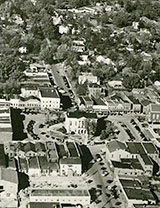 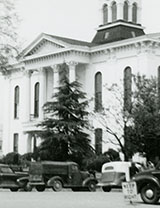  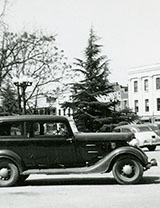 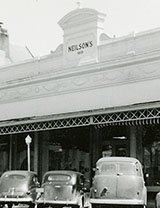 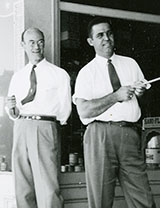 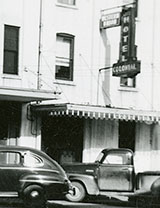 
Middle- and upper-class houses are a favorite subject in these photographs. Most of these below were built before the Civil War, including Faulkner's own home, Rowan Oak - the first in the second row. The four-column design of the porticos was a conspicuous feature of many of Oxford's antebellum mansions: see the house next to Faulkner's, which could be one of several in the town. The Samuel Carothers who in the 1830s built the house on Oxford's Jefferson Avenue that Dr. Thomas Isom later owned and improved is not directly linked to the Carothers who built the plantation in Yoknapatawpha's northeast corner, but Faulkner may have consciously borrowed his name. The Carter-Tate house was one of a number of abandoned or decaying big houses that were still part of the local landscape as late as the 1950s. 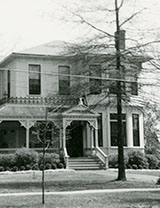 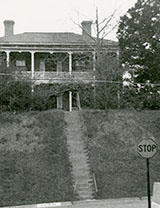 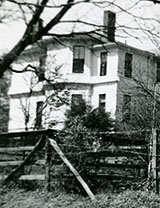 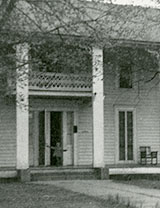 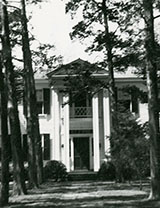  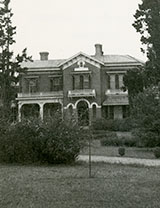 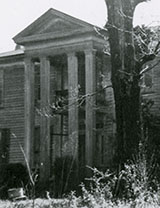
Apparently at first there was some local animus against making a movie about a possible lynching on the streets of Oxford, but once the filming began the local population found the process very entertaining, and eagerly took advantage of Brown's desire to use townspeople as extras in the crowd scenes. The second photo below features Elizabeth Patterson, a seasoned actress who plays Miss Habersham, with two extras in front of a re-named drugstore. The third photo seems to have been taken while the movie-makers were filming an early scene in the town's barber shop. The crowd seems to include both extras and onlookers - and the man standing in the middle of the street might be the director himself. It's not clear what scene is being shot in that last photo, but the interest of the spectators is obvious.  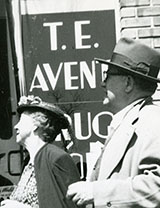 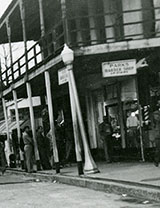 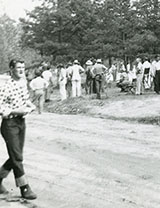
White members of the cast and crew were housed at the University of Mississippi, but the African American actors stayed with local black families. Although over a third of Oxford's population in 1950 was black, there are no African Americans among the extras and locals in these crowds; that is consistent with the novel, where as long as the threat of a lynching looms over Jefferson the Negroes all stay out of sight - in both the novel and the film they return to the streets after Lucas Beauchamp's innocence is established. But two of the photographs feature real members of the local black population (below at left). The first of the two Presbyterian churches (below at right) is in town. The other is in College Hill, an area four miles north of Oxford that was site of an antebellum Presbyterian community that included the short-lived North Mississippi College, which was the origin of "The Seminary" in the Snopes trilogy. This church might also have been a model for the church in The Unvanquished: before the Civil War it featured a gallery for the enslaved people who attended services, which the slaves entered via pair of staircases and small doors. The stairs were taken down after Emancipation, but you can still see the closed doorways just above the two main entrances. 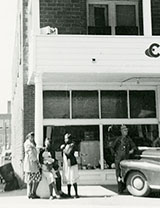 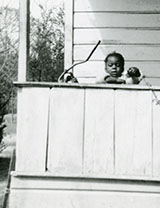 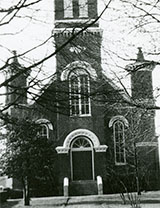 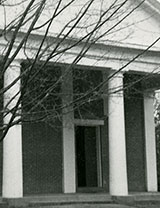 Below: Faulkner with Clarence Brown (both seated) at some point during the making of the film. A decade later Faulkner told an audience at Virginia that Brown's Intruder in the Dust was his favorite of the movies that had been made from his works: "I thought that was a—a pretty good picture. It was a good deal like my book." 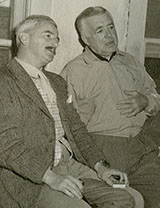 SOURCES: Charles S. Aiken, William Faulkner and the Southern Landscape (Athens: University of Georgia Press, 2009); Don H. Doyle, Faulkner's County: The Historical Roots of Yoknapatawpha (Chapel Hill: University of North Carolina Press, 2001); Thomas S. Hines, William Faulkner and the Tangible Past (Berkeley: University of California Press, 1996); Ward L. Miner, The World of William Faulkner (New York: Cooper Square Publishers, 1963); Herman E. Taylor, Faulkner's Oxford: Recollections and Reflections (Nashville: Rutledge Hill Press, 1990). For assistance in digitizing these photos and permission to include them here, we are grateful to Kyle Hovious at the University of Tennessee Library. Help identifying the photos was provided by Jay Watson, Howry Professor of Faulkner Studies and Professor of English, University of Mississippi. Citing this source: |
